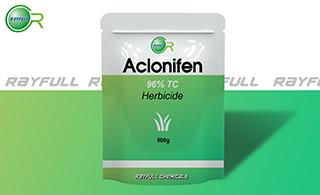Aclonifen
  ұҪІЭГС ұҪІЭГС
Introduction: Aclonifen is a diphenyl-ether herbicide, which can be used for weed control management, in specific for sunflowers. Its mode of action involves, the inhibition of carotenoid synthesis and suppression of protoporphyrinogen oxidase enzyme involved in the chlorophyll synthesis pathway.
Common name: Aclonifen
Another name: Bandur; 2-Chloro-6-nitro-3-phenoxyaniline; Challenge; Benzenamine, 2-chloro-6-nitro-3-phenoxy-; Aclonifen [BSI:ISO]; CME 127; etc.
Chemical name: 2-chloro-6-nitro-3-phenoxyaniline
Empirical formula: C12H9ClN2O3
Structural formula:

Mol. Weight: 264.66 g/mol
CAS No.: 74070-46-5
Specifications
Leading Aclonifen supplier
Aclonifen 96% TC
Aclonifen 600 g/L SC
Packing:
BULK PACKING
Powder: 25kg/Bag, 25kg/Drum, 50kg/Drum etc.
Liquid: 200L/Drum, 20L/Drum, 10L/Drum etc.
SMALL PACKING
Powder: 1kg/Alu bag, 500g/Alu bag, 200g/Alu bag, 100g/Alu bag, 50g/Alu bag, 15g/Alu bag etc.
Liquid: 5L/Drum, 1L/Bottle, 500ml/Bottle, 250ml/Bottle, 100ml/Bottle, 50ml/Bottle etc.
Customerized packing label
Aclonifen FAO standard
Professional registration
HAZARDS IDENTIFICATION
Hazard statement(s)
H317 (77.98%): May cause an allergic skin reaction.
H351 (77.98%): Suspected of causing cancer.
H400 (100%): Very toxic to aquatic life.
H410 (100%): Very toxic to aquatic life with long lasting effects.
Precautionary statement(s)
P201: Obtain special instructions before use.
P202: Do not handle until all safety precautions have been read and understood.
P261: Avoid breathing dust/fume/gas/mist/vapors/spray.
P271: Use only outdoors or in a well-ventilated area.
P272: Contaminated work clothing should not be allowed out of the workplace.
P273: Avoid release to the environment.
P280: Wear protective gloves/protective clothing/eye protection/face protection.
P281: Use personal protective equipment as required.
P302+P352: IF ON SKIN: wash with plenty of water.
P308+P313: IF exposed or concerned: Get medical advice/attention.
P321: Specific treatment (see ... on this label).
P333+P313: IF SKIN irritation or rash occurs: Get medical advice/attention.
P363: Wash contaminated clothing before reuse.
P391: Collect spillage.
P405: Store locked up.
P501: Dispose of contents/container to an approved waste disposal plant.
Supplemental Hazard Statements: none.
MAMMALIAN TOXICOLOGY
Acute toxicity: 1) Acute oral LD50 for rats is >5000 a.i.mg/kg. 2) Acute dermal LD50 for rats is >5000 a.i.mg/kg. 3) Acute inhalation toxicity LC50 (4 h) for rats is >5.06 a.i.mg/L. 4) Skin irritation: Non-irritating to skin (rabbits). 5) Eye irritation: Non-irritating to eyes (rabbits). 6) Skin sensitization for guinea pig: Non-sensitizing.
NOEL: (2 y) for rats is 7 mg/kg/day; (18 m) for mice is 7.1 mg/kg/day. Other Not genotoxic.
ADI 0-0.07 mg/kg b.w.
Classification:
WHO Classification: U (Unlikely to present an acute hazard)
EC Risk Classification: N - Dangerous for the environment: R50, R53
US EPA Classification (formulation): No consensus across products or no products available
ECOTOXICOLOGY
Effect on birds: Acute oral LD50 for Bobwhite quail is >2000 a.i.mg/kg. Effect on fish: Acute LC50 (96 h) for Rainbow trout is 0.67 a.i.mg/l. Effects on aquatic invertebrates: Acute EC50 (48 h) for Daphnia magna is 1.2 a.i.mg/l. Effects on algae: Acute 72 hour EC50 for Navicula pelliculosa is 0.47 a.i.mg/l. Effects on bees: contact acute 48 hour LD50 is >100 a.i.ҰМg/bee, oral acute 48 hour LD50 is >100 a.i.ҰМg/bee. Effects on earthworms: Acute 14 day LC50 is 150 a.i.mg/kg.
ENVIRONMENTAL FATE
Animals In rats, following oral administration, 62-65% is excreted in the urine, principally in the form of polar compounds. No bioaccumulation. Plants In plants, hydroxylation occurs on both benzene rings. DT50 c. 14 d. Soil/Environment In sterile water, stable between pH 3 to 9. DT50 in water in presence of micro-organisms c. 1 mo. In soil, DT50 36-80 d (22Ўж). Koc 5318-12 164. Unlikely to leach: -0.13 < GUS < 0.64.
Usage: Aclonifen was introduced by Celamerck GmbH & Co. (became Shell Agrar). It is a nitrophenyl ether herbicide used for the pre-emergence control of grass and broad-leaved weeds.
Application: Biochemistry Inhibits carotenoid biosynthesis; target enzyme not known. Mode of action Systemic, selective herbicide. Uses Pre-emergence control of grass and broad-leaved weeds in winter wheat, potatoes, sunflowers, peas, carrots, maize, and other crops.
| 






